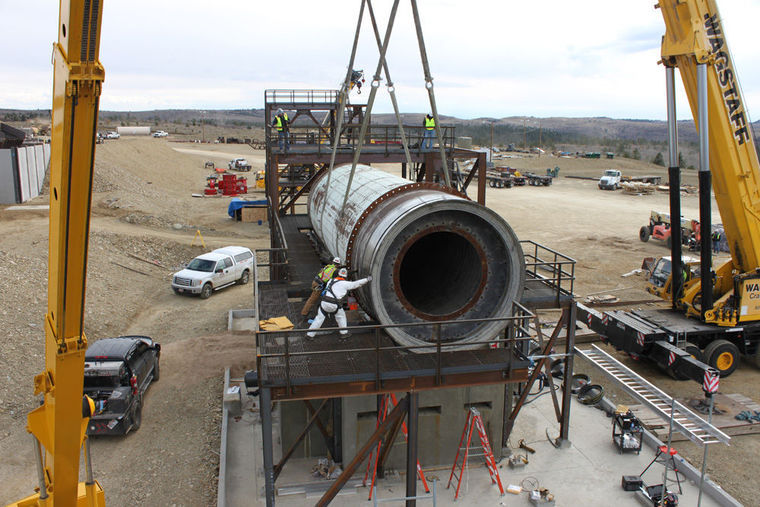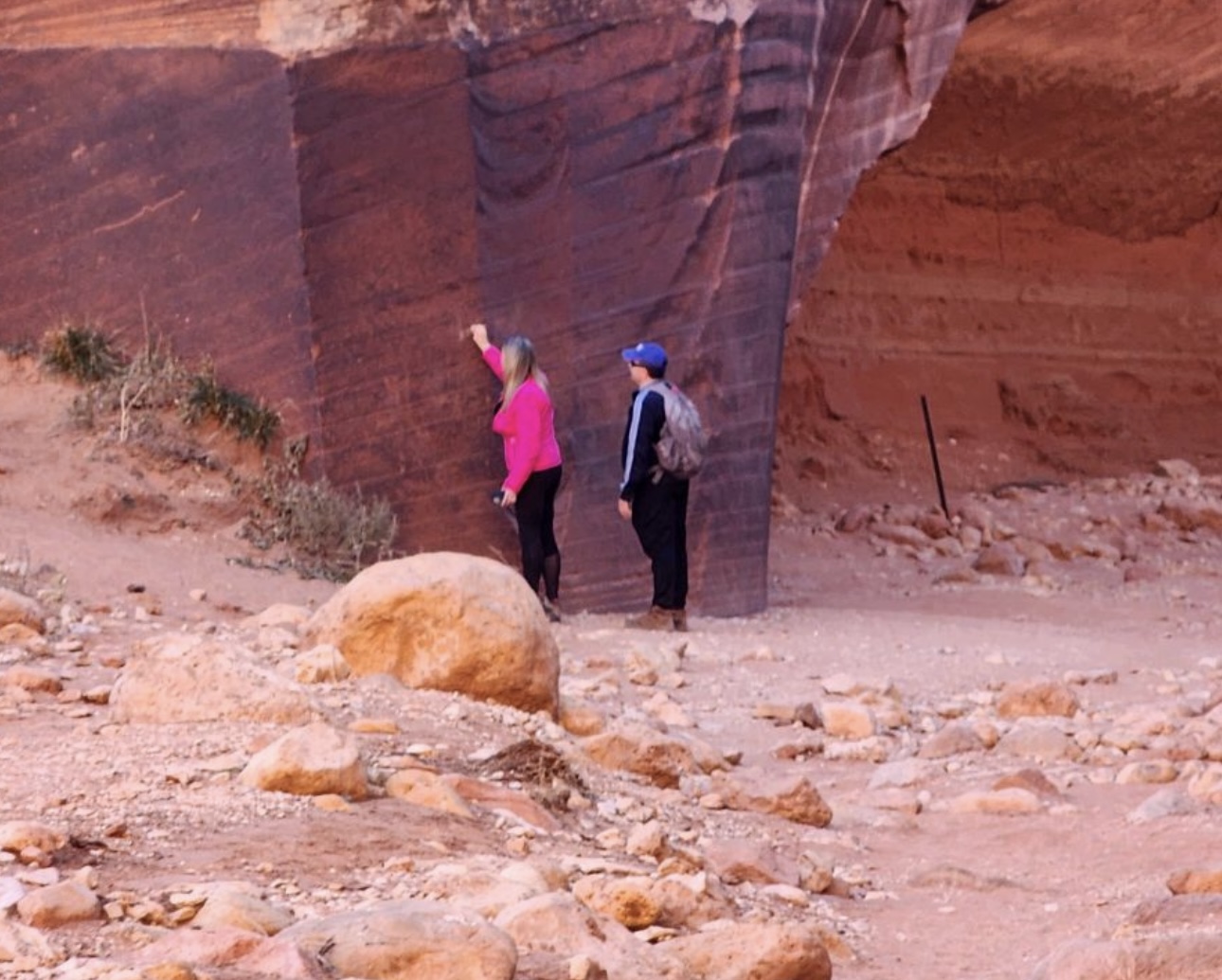Some information may be outdated.
As full-scale construction resumes at a proposed oil sands mine in the Book Cliffs, activists returned to the area last weekend to call attention to the developer’s controversial plans for the site.
On Sunday, June 19, twenty protesters were arrested and charged with criminal trespassing when they entered property that Canadian company U.S. Oil Sands leases from Utah’s School and Institutional Trust Lands Administration (SITLA). Another 80 or so individuals remained at a nearby camp, where their role was to provide support, said Moab resident Sarah Stock, one of those arrested on Sunday.
From his Calgary office, U.S. Oil Sands CEO Cameron Todd said he has “no problem with people planting flowers,” but objects to people putting themselves at risk when they enter an industrial mining site.
“I think this is an old story,” he said. “They’re only doing it to get media attention.”
Activists began the day with a ceremony and prayer before hiking across a gully and through an aspen grove, before entering the project site, which is located near the Grand and Uintah county lines about 65 miles northeast of Moab. There, the group planted several types of native grasses and other plants such as sage, globemallow and yarrow. Using picks and shovels, and permaculture techniques, the protesters created a small swell to catch water to sustain the plants.
Stock said the Tavaputs Action Council, a coalition of grassroots groups opposed to the oil sands project, wants to reclaim the land, and stop the use of public funds for county and state policing of the Canadian company’s development project. Stock is a member and one of the founders of Canyon Country Rising Tide, a group that says it’s dedicated to “climate justice on the Colorado Plateau.”
Protesters were also charged on Sunday with resisting arrest when Uintah and Grand County Sheriff’s deputies asked them to leave the area, and instead the activists linked arms and began singing, Grand County Sheriff’s Lt. Kim Neal said.
“They were all given the opportunity to leave,” he said.
Two sheriff’s deputies spent the night in the area to monitor the situation after the county learned of the planned action via the group’s web site, Neal said. Thirteen individuals were booked into the Grand County Jail, while the other seven were taken to the Uintah County Jail. They were released after posting bail.
Salt Lake City resident Lauren Wood said she was in the area as a supporter in solidarity with those who participated in the action.
“We gathered on public lands to meet and talk about how to shift the narrative of the future of this landscape away from tar sands,” Wood said. “We want to re-seed a different future and transition away from dirty fossil fuels, which threaten the climate’s future and our immediate health and well-being here and now.”
Full-scale mine construction resumes
U.S. Oil Sands recently resumed full construction at the site after the company achieved successful financing in May, Todd said. Construction had slowed down in February while U.S. Oil Sands sought additional investor funding for its project.
“We expect to be in production before the end of the year – though there’s no specific date,” Todd said.
The Utah Division of Oil, Gas and Mining issued a permit to U.S. Oil Sands in 2010, to develop the mine. Projected mining start dates have been postponed several times.
The company says it plans to extract oil by separating the thick, tarry substance called bitumen from sand formations. The project would be the first of its kind in the United States. The company has a lease to strip mine up to 32,000 acres, but is starting with a 218-acre area near PR Spring.
Many of the nation’s oil sands deposits are located in eastern Utah’s Uintah Basin. The oil sands were formed 45 million years ago when organic deposits of driftwood, leaves, algae and animals settled to the bottom of a giant inland lake and were buried by sand and silt.
Water usage in dispute
Initially, the company expects to produce 2,000 barrels of oil per day.
The project is projected to use “roughly” two barrels of water for every barrel of oil produced, Todd said.
Water will come “from a deep aquifer underneath, about a half-mile underground,” he said.
U.S. Oil Sands has drilled five wells, three of which were dry, Living Rivers Conservation Director John Weisheit said.
While the company never expected to drill as deep as they did, it has no expectations of running out of water, Todd said.
Though water was eventually found in the other two wells, Weisheit said he doesn’t believe it’s enough to sustain a mining operation. He’s concerned that the company could eventually seek to build a pipeline to the Green or Colorado rivers.
“It’s not a bountiful aquifer,” Weisheit said. “They have not solved the water problem.”
Weisheit is also concerned that PR Spring will become polluted from the nearby mining.
Todd said that PR Spring gets its water from the surface, and that it is separated from the groundwater by different rock formations.
“We will monitor the quality of water in those areas,” Todd said.
Water quality monitoring wasn’t required initially of U.S. Oil Sands until Western Resource Advocates filed a legal challenge on behalf of Living Rivers. The Utah Division of Oil, Gas and Mining decided a water quality monitoring program and compliance with federal air quality regulations were necessary as conditions for approving the company’s expansion request.
The Sierra Club Utah Chapter claims that extraction of oil sands produces three times the heat-trapping carbon dioxide pollution as conventional oil and also uses huge amounts of water.
Todd said the Utah oil sands project differs from Canada’s tar sands development where strip mining has negatively impacted vast areas of indigenous lands, forests and wetlands in northern Alberta.
“We have a very efficient process,” Todd said. “Oil sands development of Canada uses old technology, that results in huge tailings ponds unfit for drinking or wildlife. Our company uses a (citrus-based) solvent that does a much better job of separating the oil. We expect our process to expand to other parts of the world.”
Arrests follow earlier action at site
Two weeks ago, 10 protesters were arrested at the site and charged with trespassing – although civil disobedience wasn’t the intention that weekend, said one of the arrestees, Salt Lake City resident Natasha Deininger.
Opponents of the oil sands project have held vigils at the site for the past several years.
The seven women and three men apprehended on June 10 were participating in an event that Utah Tar Sands Resistance called a “family campout.” The family campouts are not to be confused with “Action Camps,” where activists talk about strategy for opposing oil sands development and plan direct actions, Deininger said.
She said they were doing a small biodiversity study – checking plant species and numbers in a wooded area next to the mine site, comparing data to what was found when they visited the area a year ago. SITLA had issued a public closure order for the property in response to prior protests in the area.
When the group emerged from the wooded area they were met by Ronald Barton, a law enforcement agent with the Utah Attorney General’s Office who is assigned to work with SITLA.
“We were detained on Seep Ridge Road for four hours,” Deininger said. “He did not tell us why we were being detained; he didn’t say we were under arrest.”
In his probable cause statement, Barton said the detention was prolonged because of the time it took the Uintah County Sheriff’s Department to respond.
The statement also says he declined to tell the individuals they were going to be arrested because he feared they might try to escape and handcuffing them at that point was problematic.
Children whose parents were arrested remained at the campsite with members of the group who did not participate in the direct action.
Both Stock and Deininger questioned why SITLA, which manages trust lands on behalf of Utah’s public schools and other beneficiaries, is spending money on security for a Canadian company doing business on Utah trust lands.
“It’s kind of a handout to the fossil fuel industry; a hidden subsidy,” Deininger said.
Utah Attorney General’s Office communications director Dan Burton said Barton is not acting as security for the company, but as a law enforcement officer with the state.
Protests come as developer resumes full construction at site
Appreciate the coverage? Help keep local news alive.
Chip in to support the Moab Sun News.





